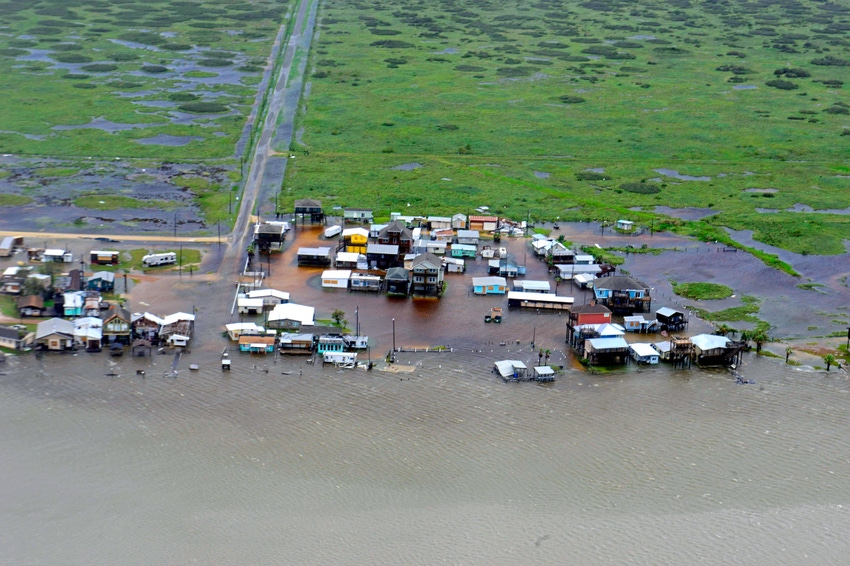
South Texas needs help—lots of it and quickly
Farmers pushed hard to harvest cotton remaining in the fields. Some ran out of time. But even those who completed cotton harvest may not have been spared heavy losses. Many of the wrapped, round bales and tarped modules remained outside, vulnerable to the elements. Much of that cotton is likely destroyed.

It will be weeks, maybe months, before officials have even a ballpark figure of losses from Hurricane Harvey. And coming to some estimate of how much farms and ranches lose from what is being called the worst weather disaster to hit Texas in decades, maybe ever, may take even longer.
One thing we do know—it is bad.
Reports last week as Gulf Coast farmers and ranchers prepared as best they could for the coming disaster included a mix of relief and trepidation. Much of the season’s cropland had been harvested, but much remained in the field and vulnerable to what everyone knew would be devastating winds and torrential rain. Those dire predictions were realized—and then some. The storm came ashore as a Category 4 hurricane, packing winds of 156 miles per hour. Storm surge pushed as high as 13 feet, leveling most everything in its path. Footage of the small towns of Rockport and Port Aransas show unbelievable devastation.
Houston, spared from the howling winds of Harvey, may take the biggest hit from the hurricane. By Sunday, more than 30 inches of rain had fallen on the nation’s fourth largest city. Floodwaters turned Interstate highways into rivers. The city was awash. People were perched on rooftops waiting for rescue. Television footage of elderly, debilitated citizens trapped inside a flooded facility was heartbreaking. While watching from the safe haven of my den, 1,000 plus miles away, the impulse to help and the futility of knowing that I could do little, even if I were within driving distance of Houston, was painful.
UNIMAGINABLE TRAGEDY
Footage this morning of a mother trapped on a rooftop, where she and her family had spent a long, terrifying night, hurt my soul. She was able to get into Good Morning America’s storm coverage with her smart phone video camera. The GMA crew contacted the Red Cross, so I pray they were rescued. Her final words before she signed off still haunt me: “Please help us. I’m scared.”
So far, officials say eight people have perished from the storm. That number, tragically, likely will go up.
Of lesser importance is property damage, which will be massive. The flooding in Houston will leave little of the city undamaged. Rockport, Port Aransas, Corpus Christi and other towns and communities along the coast will face monumental rebuilding.
Agriculture expects heavy losses. The days before the storm, livestock owners were trying to move animals to safety. The question today is how many animals were still in harm’s way when Harvey hit.
Farmers pushed hard to harvest cotton remaining in the fields. Some ran out of time. But even those who completed cotton harvest may not have been spared heavy losses. Many of the wrapped, round bales and tarped modules remained outside, vulnerable to the elements. Much of that cotton is likely destroyed.
Read more http://bit.ly/2xr1uta
Heavy rains stretched well into central Texas where cotton and other crops were unharvested. Damage will be significant.
I’ve asked myself the last few days: How can we help? Keeping folks informed is one thing but seems hardly enough. I will be looking for opportunities to donate and encourage others to do the same. Someone on Facebook suggested that farmers would be okay since they have crop insurance—a comment that displays more ignorance than malice, I would hope. Crop insurance will be important, but it will not go far enough. Farmers and ranchers will need help. If you know of organizations that will direct donations to help agriculture, let us know. We will pass them along. Please make certain they are legitimate.
[USDA offers assistance http://bit.ly/2wb6Z0i ]
We published numerous stories last spring and into the summer about wildfire relief efforts up in the Texas Panhandle and into Northwest Oklahoma and Kansas. We were uplifted, but not surprised, by the amount of support those ranchers received from across the nation. Now, South Texas needs help—a lot of it. It’s time to step up again. And keep those folks in your thoughts and prayers as they begin the long process of rebuilding, recuperating and recovering from an unimaginable tragedy.
About the Author(s)
You May Also Like





